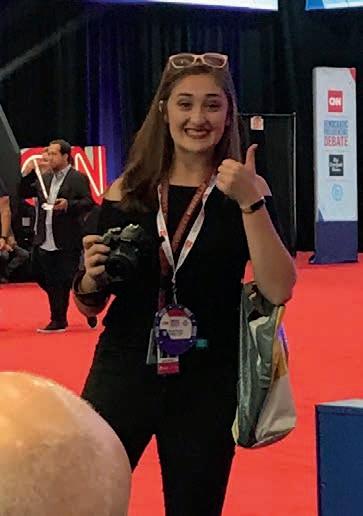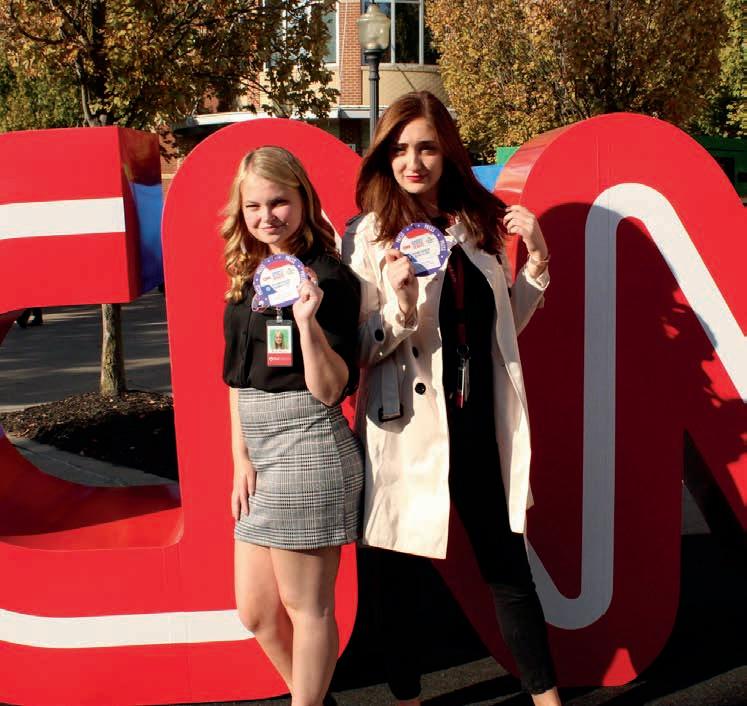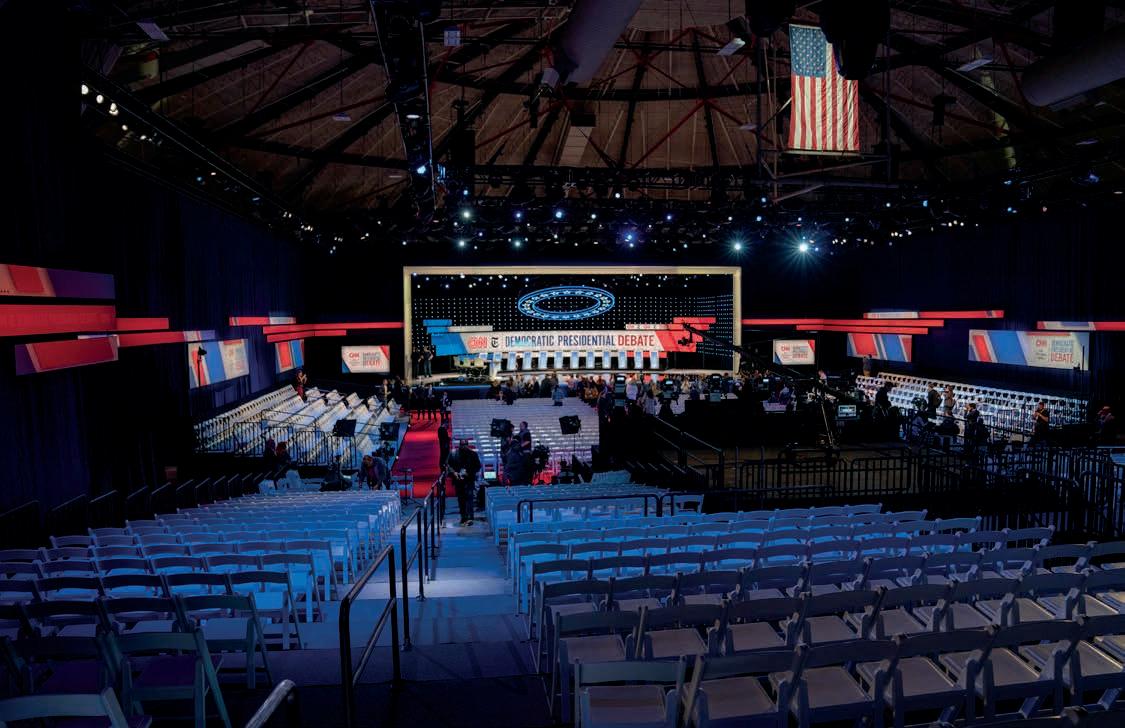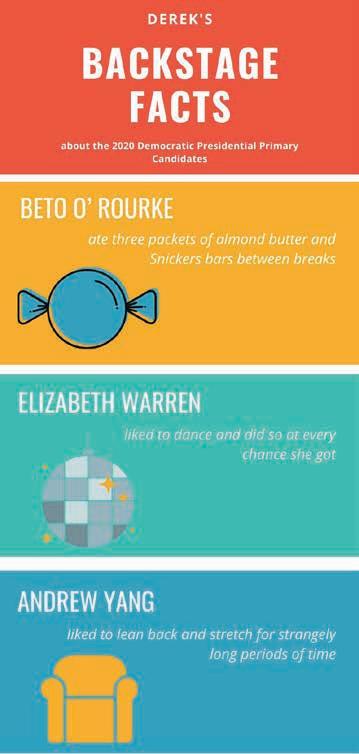
8 minute read
Debate debrief
A cross-campus look at Otterbein’s debate debut W hat started out with discussions of a simple town hall with CNN, turned out to be one of the biggest, most publicized events brought to Otterbein University: the 2019 Democratic Presidential Debate in Westerville, Ohio. Though it was a pleasant surprise for Director of Events and Conferences Matthew D’Oyly, he recalls the amount of planning that took place behindthe-scenes to pull off this 50-minute spectacular. “I remember when we found out that it was the debate that we’d be hosting. There was a small group of us on a conference call with one of CNN’s senior vice presidents. They started by saying, ‘Everything we’re about to tell you is something you cannot share with everyone.’ Then we started signing the nondisclosure agreements. It was really exciting to have that opportunity and to know that eventually, everyone would find out Otterbein would be the location of the debate. When it came to preparing for the event, the biggest thing was making sure we had all the right players at the table. Originally, CNN took a few site visits in early August with about 30 people from different areas of the company, like the lighting team, the building team, logistics and producers. We also wanted to make sure that all the right players were representing Otterbein and Westerville. The next big thing was overcommunicating and doing whatever we could to make sure everyone knew what the plan was and how we were going to execute it. We really wanted the messaging to different audiences to be clear and concise. Although CNN had to approve our original press release, we were able to craft our later messages together as a team to make sure we were hitting all the different points in a timely way. During the debate itself, the first hour was a little interesting. We hit a fire code and were at maximum capacity for people in the Rike Center. I was in charge of getting CNN talent into the building by switching other people out. The Rike Center can normally hold more people, but because of the platforms and other additions, the occupancy level was decreased. At the same time, there were a lot of other logistics happening, like popping in some extra chairs at different places throughout the building. No one in the audience was allowed out of their seats during the event because of the distraction it could pose to the candidates, so we had to go through back rooms to get from one spot to another without ever being seen on television. Now that the debate is over, I still do a lot of logistics for Otterbein, but I have less pressure and more time to plan. Honestly, it’s a little hard to go from a constant pace where you’re working 20 hours a day to having plenty of time to respond to an email, but I really did enjoy my job.” ■ As told to Gillian Janicki ’20
Theatre major gets a shot at journalism As told to Katie Frame ’22 T he oddest part about the debate for sophomore design tech theatre major Julia Kelley was the fact that she got to go. Photos provided by Julia Kelley
Kelley, a photographer for T&C Media, spent the day running around campus and Uptown, taking photos of anything and everything she could before heading into the media room in the Clements Recreation Center for the event, where she was lucky enough to score press credentials.
“The day of the debate started out as a blur. I headed toward Uptown and used my media access to its fullest extent, trying not to be afraid to get good shots of protestors, security and other people milling around. At one point, I thought I’d photographed Tom Steyer, only to find out later that it was definitely not Tom Steyer.

While in Java Central, my fellow T&C Media reporters and I ran into a reporter from the Washington Post. She was super nice and asked us all about student media at Otterbein. She even gave us all her card and her personal phone number in case we needed anything throughout the night. Having the card of a professional journalist was mindblowing for me.
Once we got settled in the Rike Center, I got to work on editing photos for the pre-debate stories the reporters had been working on. When I had a spare moment, I jogged over to Cowan Hall, where the university was hosting a forum with journalists from the New York Times’ political desk and a debate watch-party. After passing through a crazy amount of metal detectors, I spent some time interviewing attendees about how they were enjoying the debate so far.
It was odd to me how people stiffened up when I told them I was a reporter, but once I explained more about the perspective I was looking for, I ended

up having some great conversations. Once the debate was over, I made my way into the spin room in the Clements Recreation Center, where candidates answered questions from press. I’ve been to New York City and have been stuck in some pretty rowdy crowds, but the spin room was unlike anything I’ve ever seen before. I was absolutely stunned by the atmosphere of the room. I was standing right beside people who were live on FOX News, yet everyone was so unexpectedly casual. As he was walking past, Cory Booker fist bumped me, which was something I’ll never forget.
The whole day, I was just basking in this amazing experience that I got to be a part of. Even all these months later, that night still doesn’t quite seem real.” ■
Taking part in history As told to Michaela Spangler ’21 K ain Anderson, a junior music education major, got to dip his toes in a variety of different roles during the debate, from acting as a sound and lighting stand-in for Beto O’Rourke, to working as an usher for the VIP section during the event. Read more about Anderson’s once-in-alifetime opportunity volunteering with CNN. “There were 13 other students who were also working as stand-ins on Saturday in the Rike Center, one person for each candidate and two people for moderators Erin Burnett and Anderson Cooper. I was assigned to roleplay as Beto O’Rourke and was immediately instructed to interrupt the other students as much as possible because that’s how he responds during debates. Everyone else had different instructions based on the personalities they were filling in for. The CNN crew put microphones on us, adjusted the lighting and camera angles, and from that point forward, we were standing at our podiums for the next four hours. They asked us things like, “What’s your favorite spot on campus?” or “What are your plans for Halloween?” If someone said their favorite spot was the library, I’d immediately interrupt as much as I could and start talking over them, which I do well naturally. The CNN crew checked sound and lighting the entire time, occasionally asking us to turn our heads to get as many angles as they could. On the day of the debate, I was an usher for the VIP section, which was awesome. I was right down in front of the stage

where all the action was happening. I wasn’t far from Joe Biden, Rosario Dawson [actress and girlfriend of Corey Booker], Chasten Buttigieg [Pete Buttigieg’s husband] and [Otterbein] President [John] Comerford. I got to be near them all night while I was checking tickets. A lot of people came up for pictures, so I oversaw making sure they actually left the section once they had their picture taken.
After the debate was over, I got to meet Pete Buttigieg, Joe Biden, Elizabeth Warren and Kamala Harris. I’m so glad I got to be a part of it. I was actually supposed to go to New York that weekend. My friend and I bought plane tickets, but when they announced the debate was being held at Otterbein, I was like, ‘I don’t want to go anymore.’ I wanted to be here to experience it because it was such a historical moment. I’ll remember it all.” ■
What it was really like: working backstage at the debate As told to Mari Smith ’20 S ometimes, the quirkiest jobs end up being the most fun. Derek Parham, a senior journalism and media communication major, experienced this firsthand while volunteering as a runner for CNN both leading up to and during the debate. Read more about some of his wacky experiences and the fun facts he learned about the candidates in his retelling of the debate experience. “The day before the debate, CNN had me doing odd jobs, like moving around equipment that needed set up and driving out to hotels to drop off backstage passes to whomever was related to the candidates. That was cool, to go out into the city to do things like that for them. Once the debate started, I was working with CNN’s public relations and photography team, running around backstage and delivering SD cards back and forth between the two teams. I was even included in a group chat with each of the team members. There were a couple of times throughout the night where I almost walked out onto the stage while the candidates were answering questions, and I was like, ‘Oh no, I can’t do that. Bernie Sanders is right there.’ I was also in charge of a few other things, like getting water and snacks for the candidates’ trailers and acting as a seat filler for their family members. Whenever someone from their family would get up to leave, I would take their place so the candidate could look out into the crowd and know where their relatives were sitting. Basically, I got to sit in an auditorium chair and wave at Sanders so he would know where his wife was, which was cool.” Photos provided by Otterbein University ■











